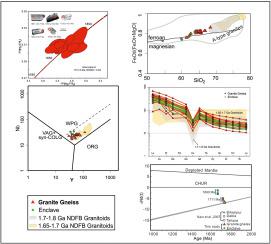Geoscience Frontiers ( IF 8.9 ) Pub Date : 2020-10-15 , DOI: 10.1016/j.gsf.2020.09.013 Manoj K. Pandit , Hitesh Kumar , Wei Wang

|
The basement granite gneisses from the north-central Aravalli Craton in NW India were investigated for geochemistry and geochronology. In a peneplain terrain, the granite gneiss outcrops are scanty and samples were collected mainly from two small hills and several ground-level exposures in the Sakhun – Ladera region. Well-foliated granite gneiss is the dominant lithology that also hosts dark, lenticular enclaves, and is in turn, intruded by mafic dykes. The granite gneiss has silica content ranging from 61.37 wt.% to 68.27 wt.% that marks a slight overlap with the enclaves (54.32 wt.% to 62.17 wt.%). Both groups have a high K2O/Na2O (~2 or higher) ratio. Geochemically, the granite gneiss classify as granite – granodiorite, and enclaves as granodiorite - diorite. The In-situ LA-ICP-MS zircon U–Pb geochronology of granite gneiss has yielded a statistically valid 1721 ± 9 Ma age that we interpret as the emplacement age for the granitic protolith. Geochemical characteristics of granite gneiss underline fractional crystallization of an I-type melt as the main process, and continuity of trends in enclaves underlines their mutual genetic link. The genetic association is further verified by a consistency in the trace element characteristics and REE patterns. The Nd-isotope signatures define a single grouping for both granite gneiss and enclaves, with εNd(t) values ranging from −6.38 to −6.61, further substantiating a common source. The geochemical tectonic discrimination schemes consistently point toward an extensional setting and A-type characteristics for granite gneiss and enclaves. These are analogous to the coeval (1.72–1.75 Ga), A-type granitoids from the Khetri and Alwar basin in the North Delhi Fold Belt, implying a much larger areal extent for the Paleoproterozoic anorogenic magmatism in the northern segment of the Aravalli Craton. The Paleoproterozoic age for the presumed ‘Archean’ basement in this region offers tacit evidence that the BGC – II is a stratigraphically younger terrane as compared to the Archean age, BGC – I.
中文翻译:

中北部Aravalli Craton A型地下花岗岩的地球化学和地球年代学:对西北印度块古元古代地球动力学的影响
对印度西北部中北部Aravalli Craton中地下花岗岩麻片岩进行了地球化学和年代学研究。在一个平原地区,花岗岩片麻岩露头很少,并且主要从Sakhun – Ladera地区的两个小山丘和几次地面暴露中采集样品。片状花岗岩片麻岩是主要的岩性,它也具有深色的双凸透镜飞地,进而又受到铁镁质岩脉的侵入。花岗岩片麻岩的二氧化硅含量为61.37重量%至68.27重量%,这与飞地略有重叠(54.32重量%至62.17重量%)。两组的K 2 O / Na 2高O(〜2或更高)比率。从地球化学上讲,花岗岩片麻岩分类为花岗岩-花岗闪长岩,而飞地分类为花岗闪长岩-闪长岩。花岗岩片麻岩的原位LA-ICP-MS锆石U-Pb年代学产生了统计上有效的1721±9 Ma年龄,我们将其解释为花岗岩原生岩的沉积年龄。花岗岩片麻岩的地球化学特征以I型熔体的部分结晶为主要过程,而飞地趋势的连续性则强调了它们的相互遗传联系。微量元素特征和REE模式的一致性进一步验证了遗传关联。钕同位素签名定义既花岗岩片麻岩和飞地的单个分组,具有ε钕(吨)值介于-6.38至-6.61之间,进一步证实了一个公共来源。地球化学构造判别方案始终指向花岗岩片麻岩和飞地的伸展背景和A型特征。这些类似于来自北德里折褶带的赫特里和阿尔瓦盆地的同时期(1.72-1.75 Ga),A型花岗岩,这意味着阿拉瓦利克拉通北部的古元古代造山岩浆作用的面积范围要大得多。该地区假定的“ Archean”地下室的古元古代年龄提供了隐性证据,表明BGC – II是较Archean时代BGC – I地层年轻的地层。



























 京公网安备 11010802027423号
京公网安备 11010802027423号